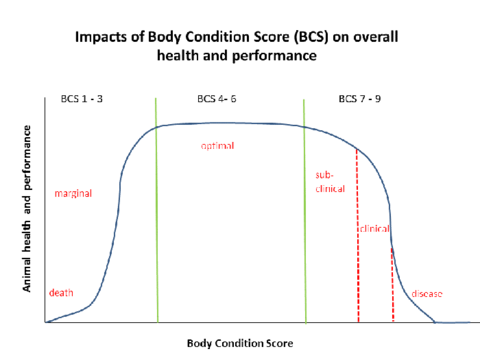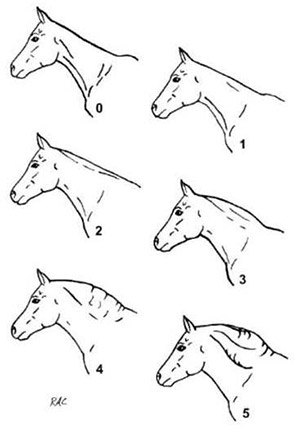Quick facts
- Horse obesity is a major health issue in the horse industry
- Overweight horses are prone to disease, overheating and poor performance
- Restricting diets and easing into regular exercise can help horse’s reach a healthy body weight
- Routinely monitor your horse’s body weight
- Body condition scores of 4 to 6 are ideal
Is my horse overweight?
Several methods are available to help determine if your horse is overweight. If more than one of these methods indicates your horse is overweight, work with an equine nutritionist and veterinarian to plan a body weight loss program.
Body condition score
Body condition scoring (BCS) evaluates the fat deposit under the horse’s skin in six areas.
- Neck
- Withers
- Behind the shoulder
- Along the back
- Rib area
- Tail head
BCS uses the Henneke scale (1=poor; 9= extremely fat) where horses scoring:
- 4 to 6 are ideal
- 7 to 9 are overweight to obese
For more information on body condition scores visit Purina Animal Nutrition’s website. To learn how to figure out your horse's body condition score watch our video.
Learn how to figure out your horse's body condition score
Girth to height ratio
The girth to height ratio estimates overall fat deposits and ties in to the body condition score. To calculate the girth to height ratio:
- Measure the girth and the height of your horse from the top of the withers.
- Divide the girth measurement from the height measurement.
Overweight horses have a girth to height ratio equal to or greater than 1.26, while overweight ponies have a girth to height ratio equal to or greater than 1.33.
Cresty neck score
The cresty neck score evaluates the amount of fat in the neck region of the horse. The cresty neck scores range from 0 (no visible crest) to 5 (large crest that droops to one side).
Aim to keep your horse at a cresty neck score of 2 or lower. A score of 3 or greater is usually a cresty neck and the horse is likely to be overweight and prone to metabolic disorders.
Ideal body weight equations
Researchers at the University of Minnesota developed ideal body weight equations to help determine your horse’s ideal body weight based on his or her overall frame.
To calculate your horse’s ideal body weight you need the following measurements:
- Height, from the top of the withers
- Body length, from the point of the shoulder to a line perpendicular to the point of the buttock. Don’t wrap the tape measure around the buttock.
Calculating ideal weight for different horse breeds
| Horse breed type | Ideal weight equation |
|---|---|
| Arabian | ((Length * 23.52) + (Height * 15.58)) - 1,344 |
| Draft | ((Length * 27.55) + (Height * 25.98)) - 2,092 |
| Miniature (3+ years) | 23.25 * (Length^ 0.79 * Height^ 1.74) /868 |
| Miniature (<3 years) | 33.92 * (Length^ 1.92 * Height^ 1.26) /18,209 |
| Pony | ((Length * 23.52) + (Height * 15.58)) - 1,333 |
| Saddle-type | 20.34 * (Length^ 1.37 * Height^ 1.01) /359 |
| Stock | ((Length * 23.52) + (Height * 15.58)) - 1,269 |
| Thoroughbred | ((Length * 10.69) + (Height * 23.76)) - 1,073 |
| Warmblood | ((Length * 27.55) + (Height * 25.98)) - 2,235 |
Impacts of obesity
Disease
Overweight horses are more likely to develop disorders and diseases. Some diseases they are more prone to include:
- Laminitis
- Equine Metabolic Syndrome
- Insulin dysfunction
- Elevated levels of the stress hormone cortisol
Poor performance
When a horse gains excess body weight as fat (adipose tissue), their performance and use declines.
- Bearing excess body weight impacts hoof health by weakening the hoof wall, heel buttress, and bars of the foot.
- Obesity is a risk factor for developing osteoarthritis and other joint problems.
- Excessive body weight increases muscle strain, which can make it harder to function normally.
Overheating
Obese horses can have trouble controlling their body temperature. This comes as a result of the excess fat both directly under the skin and surrounding vital organs that traps in heat. This is a concern in warmer weather, as horses can quickly become dehydrated. Overheating can also be a large factor in poor performance.
Reaching a healthy weight through diet and exercise
Restricting your horse’s caloric intake and increasing exercise is key to body weight loss. Neither done alone is as effective as a combination of the two.
Although overweight horses are at risk for numerous health problems, they can also face health problems from losing body weight too quickly. When caring for an overweight horse, make sure the horse loses body weight slowly and steadily over time. This will also help make sure the excess body weight will stay off your horse in the future.
You can use the Healthy Horse App or weight tapes to help track your horse’s body weight loss. A scale is the best predictor of body weight. But the app and weight tapes can track body weight changes over time if used correctly and frequently.
Diet
Horses at an ideal body weight usually consume about 2 percent of their body weight in feed (includes hay, grain products and supplements) daily. Limit an overweight horse’s diet to 1.5 percent of their body weight daily. For example, a 1,200-pound horse should receive 18 pounds of feed daily when restricted to 1.5 percent of their body weight.
All horses should receive the bulk of their feed and calories from hay. Different types of hay vary widely in nutritional value. We recommend feeding overweight horses a mature grass hay. Mature grass hay usually contains a relatively low number of calories, meaning you can feed more of this hay than a less mature, higher energy hay.
You should always weigh your horse’s hay ration to make sure you aren’t overfeeding. Building a simple hay scale is easy and inexpensive, and can be done with materials from your local hardware store, including a small tarp (or hay net) and hanging scale.
Reducing or removing grain from your horse’s diet will also decrease caloric intake. Many overweight horses are fed only “a handful” or very small amounts of grain. This can result in deficiencies in certain vitamins and minerals that horses must consume to stay healthy.
We recommend feeding a ration balancer in order to prevent any nutritional deficiencies. Ration balancers are commercially prepared horse feeds designed to be fed in small amounts and provide vitamins and trace minerals without additional calories.
Feeding more mature hay that is higher in fiber not only reduces caloric intake, but can also help slow a horse’s rate of feed intake. Neutral detergent fiber (NDF) is a measurement of insoluble fiber that structurally supports plants. The higher the NDF, the less a horse will consume. We consider NDF levels between 40 and 50 percent to be ideal for promoting hay intake. NDF levels above 65 percent tend to reduce hay intake by most horses, but should be used sparingly in horse diets.
Hay high in NDF (50 to 65 percent) is really useful for horses on a diet. Hay high in NDF is called “busy hay,” as horses will spend more time eating it. Use a hay analysis or work with an equine nutritionist when feeding your horse this kind of hay to make sure other necessary nutrients are balanced.
Extending the length of time horses spend foraging has been linked to improvements in horse health and wellbeing, including reductions in:
- Unwanted behaviors such as cribbing, weaving or pacing
- Ulcers
- Incidences of choke
- Spikes of insulin and glucose levels after a meal
Finding ways to slow feed intake is especially important for horses on a restricted diet. You can slow equine feed intake rates by altering how you deliver feed to your horse.
University of Minnesota research shows a slow-feed hay net can help extend the length of time it takes your horse to consume a hay meal. Horses spent the following times eating the same amount of hay when fed from different hay nets.
- 6.5 hours with a small hay net (1-inch openings)
- 5 hours with a medium hay net (1.75 inches)
- 3.4 hours with a large hay net (6 inches)
- 3.2 hours without a hay net, fed off the ground
Using a medium or small hay net to feed two meals daily could potentially allow horses to forage 10 to 13 hours daily. More time spent foraging better mimics a horse’s natural grazing behavior and will help keep glucose and insulin levels steady throughout the day. This may help reduce the risk of developing metabolic disorders.
Texas A&M University (PDF) tested a specialized feeder and found the feeder slowed grain intake and reduced spilling. Horses spent 21 to 60 additional minutes eating grain from the feeder compared to a bucket or tub. You may need to regularly clean the feeder in some situations.
North Carolina State University tested a waffle structure that be can inserted into a feed bucket. They found that the waffle insert increased grain intake time by nearly 50 percent compared to a bucket without the waffle insert.
Incorporating feed obstacles in your feeder can slow your horse’s feed intake. North Carolina State University tested grain feeding time using a bucket with four movable bocce-style balls (4 inch diameter) placed in it. They found the balls were effective at extending (by 4 minutes) and maintaining the time it took horses to consume feed after multiple days of use. Additionally, the researchers found that the balls produced the lowest glucose and insulin responses compared to other feeding methods tested.
Research by Purina Animal Nutrition confirmed feeding hay before grain slows feed intake. They found that horses ate grain slower when they fed hay 20 minutes before the grain meal. Horses ate 0.3 pounds of grain per minute when fed hay before grain. When horses ate hay and grain at the same time they ate 0.4 pounds per minute.
Exercise
Exercise accomplishes several tasks. It will
- Decrease the amount of body fat being gained by burning the calories taken in daily
- Burn up or use fat in the body, resulting in weight loss
- Enhance the health and capabilities of muscle and bone
Overweight horses are usually unfit horses. You should slowly and steadily increase the activity level of an overweight horse to prevent injuries.
A common exercise plan starts with a 30-minute combination of walking and slow trotting two or three times weekly. Work up to light work or visible sweat three to five days weekly for ½ to 1 hour a day. The exercise intensity, duration and frequency can increase as the horse loses body weight and gains fitness.
A seven-day light exercise program burns almost six times more calories daily than seven days of no exercise. This is similar to the calories in 4 to 5 pounds of grass hay or 2 to 2.5 pounds of a grain product. Exercise and diet can have a powerful effect on body weight loss that can’t always occur with exercise or diet alone.
As with humans, when horses burn off body weight and then return to their former activity level, they may start gaining weight again. A similar result may occur when they return to a maintenance-level diet. Watch for these changes and adjust diet and workload accordingly.
Reviewed in 2021




